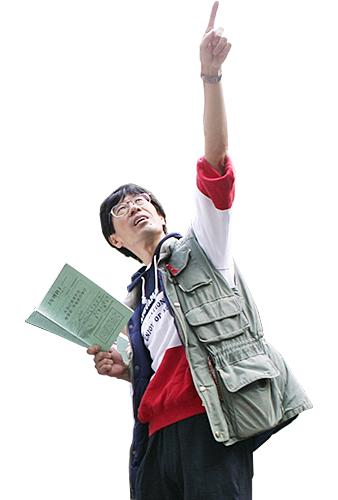理科教諭なべやんの「学内探訪」 Nabeyan's Column
2016年5月より、本校理科教諭の田邉利幸が綴った「学内探訪」コラムを連載していきます。
キャンパス内の名所や豊かな自然環境をご紹介していきます。
連載!理科教諭なべやんの「学内探訪」
<掲載に際して>
「学校」という空間は、人間が生活する環境の中でも”特異”な空間です。本校の場合主に近畿圏各地の居住地域から、900名近い人々がこの岩倉の地に通い、集い、学び、お互いを高め成長する場となっています。
そして午前8時から午後5時までの校内は、未来の無限の可能性を秘めた若者の活気が満ち満ちています。ある場面では授業としての「教科の学び」が、また「かけがえのない友人との語り合いや交流」が、そして放課後は「個性的で多様な先輩や後輩との学び合い」と、学び通しの9時間があっという間に過ぎていきます。
これらのさまざまな経験は、今後の豊かな人生を築き上げていく上で何よりも大切な宝物です。
そんな豊かな3年間を「学校環境」の視点から振り返ってみた時、この地には四季折々に変化する比叡山や北山、西に流れる岩倉川の自然の景観や、季節の移ろいを感じて多様に変遷する豊かな動植物が生息しています。そして同時に、香山建築研究所の設計による建造物、空間構成、そこに組み込まれた”芸術作品”にも注目したいと感じました。子どもたちが快適に生活できることを何よりも大切にし、校地の空間や構造物のデザイン、校舎間や空き地への動きを科学する「動線の科学」、教科教室内の機能性や教科MSの空間構成など、本校に関わるデザイン的要素のすべてが「芸術作品」であり、また、「建築工学の最先端の現場」でもあるように思うのです。いわば子どもたちは、宇宙・自然・芸術・環境・人間・工学の多様な視点から創造された作品群の中で学校生活を送っていると言っても過言ではないと思います。
ある時、何気なく校内を歩いていると、自然物や構造物の方から次から次にメッセ-ジが伝わってきました。今回そのメッセ-ジに促されて、「学内探訪」(適宜「学外探訪」も)と題する連載を記してみます。雑駁な文章で不足を感じる点は多々ありますが、ご一読いただきご批判、ご鞭撻いただければ幸いです。尚、英文Summaryは本校英語科のDavid Foremanが担当しています。
田邉利幸
第88回 絶妙! 空と雲の表情
~生徒手帳表紙デザインコンテスト最優秀作品~
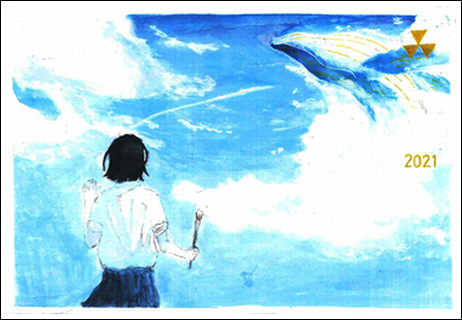
梅雨の中休みに見られる青空は1年間の中でも特別の開放感をもたらせてくれます。
そんな開放感を感じさせる作品が「2021年度生徒手帳表紙デザインコンテスト」に寄せられました。右の水彩画は、まさに5月~6月の貴重な晴れ間の空です。空の青とそこに浮かぶ雲(ちぎれ積雲)の表現が絶妙で、しばらく眺めていると、実際この空の下でたたずんでいる感覚になります。…そしてその空でクジラが跳ねる…。
さて、背をむけている人物は右手に絵筆を持っています。では左手は何を表現しているのでしょうか。みなさんはどのように考えますか。
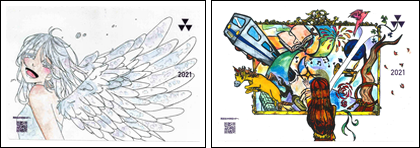 他にも多くのすばらしい作品が寄せられました。次年度も多くの作品をお待ちしています。
他にも多くのすばらしい作品が寄せられました。次年度も多くの作品をお待ちしています。
 《生徒手帳生徒デザインコンテスト》とは…生徒手帳には1枚の白い紙が手帳本体に巻いてあります。この紙に自分自身の1年間の思いを自由にデザインする企画です。
《生徒手帳生徒デザインコンテスト》とは…生徒手帳には1枚の白い紙が手帳本体に巻いてあります。この紙に自分自身の1年間の思いを自由にデザインする企画です。

The blue skies on the days when the rain of the Rainy Season takes a break make us feel a sense of freedom.
A picture that truly expresses that feeling was submitted for the “2021 Student Diary Cover Design Contest”. In the water painting we can clearly see this precious period of sunlight during May and June. As we look at this painting, the blue of the sky and the way the scattered clouds are perfectly expressed make us feel as if we are actually looking up at the sky…. and a whale jumping in the sky…
The person with their back to us is holding a brush in their right hand. What do they have in their left hand? What do you think?
Many wonderful works of art were submitted for the contest. We hope we can get as many next year as well.
The “Student Diary Cover Design Contest” is a project where students can design their own artwork on the white sheet of paper that is the cover of their student diary. This can be used as a special memory for that one year.
《Words》 梅雨 Rainy Season、生徒手帳 Student Diary、絵筆 brush、表紙デザインコンテスト Cover Design Contest
第87回 キバシリの来校!
~極レア鳥との出会い~
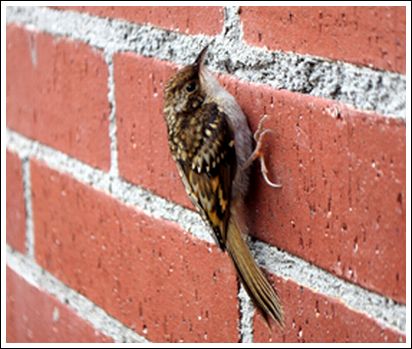
5月14日、岩倉の地で初めての出会いがありました。みなさんはキバシリという名前の野鳥を観たことはありますか?
キバシリ(Certhia familiaris)は、スズメ目キバシリ科の野鳥で、京都府では準絶滅危惧種に指定されています。『京都府レッドデ-タブック2015』には、「府内では芦生、愛宕山、比叡山などに周年生息するが、局所的で個体数は極めて少ない。ブナやミズナラなどの落葉広葉樹林、スギ、モミなどの古木のある混交林に生息している。」と記されています。

そのキバシリが14日早朝、想遠館南側のアスファルト地面にたたずんでいました。近寄っても逃げず反応がありません。校舎のガラス面に激突し脳震盪の状態のようにも思い、保護しようと軍手をはめた手を近づけるとレンガ壁の南面に飛びつきました。このままでは、イタチ等の捕食者にやられると思い鳥小屋に保護しておきました。
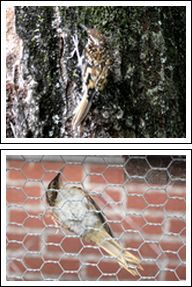
しばらくの間、安静環境の状態にしておくと、とても元気に飛び回るようになりました。これで無事に山に戻れそうだと判断し扉を開けておいたところ、近くのムクノキの幹に飛びつき、早速樹皮に隠れた虫を探していました。その後、無事飛び立ったようです。
梅雨期に入った京都ですが、今回出会ったキバシリさんが、比叡山方面などの森で元気で過ごしてくれたら、それ以上の喜びはありません。
On May 14th, I had a new experience. Have you ever seen a Eurasian Treecreeper?
The Eurasian Teecreeper (Certhia familiaris) is a family within the Passerine order of birds, and is considered to be a near threatened species in Kyoto. According to data from 2015, these birds can only be found in very small numbers, living in several places around Kyoto, such as Mt. Hiei, where a mixture of old trees are growing in the woods.
The Eurasian Treecreeper in the photos was standing on the asphalt south of the Souenkan building on the morning of the 14th. It didn’t fly away when I approached it and appeared to be concussed after hitting one of the school building’s windows, so I put on some gloves to go and help it, but it flew up and perched on the brick wall. To protect it from weasels and so on, I put it in our birdhouse.
After it had rested for a while, it seemed to have the energy to fly around, so I opened the door and let it out. It flew straight to a Muku Tree and started looking for insects. After that, it flew away somewhere. If the Eurasian Treecreeper that I met has flown towards Mt. Hiei and is living happily there, then I will be happy too.
《Words》 キバシリ Eurasian Treecreeper、準絶滅危惧種 Near Threatened Species、比叡山 Mt.Hiei、(分類上の)科 family、~によれば according to~、想遠館 Souenkan building、鳥小屋 birdhouse、しばらくの間 for a while
第86回 立志館入口の魚
~イクトゥスの意味~
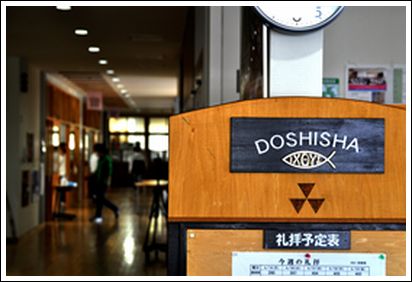
みなさんの教室がある立志館入口には右の写真のような看板がありますね。ここには1週間の「礼拝予定表」などが貼ってあって、見たことがある人も多いと思います。
今回は、「DOSHISHA」の文字の下にある”魚のようなマ-ク”について紹介します。すでにこのマークに気づいていた人はいますか?
このマ-クは「イクトゥス」(イクテュス)ichthys ,ichtusといいます。内側にはギリシャ語で「魚」と記されていますが、同時に「イエス、キリスト、神の、子、救世主」の頭文字を並べたものでもあり、初期のキリスト教徒が”隠れシンボル”として用いたものとされています。
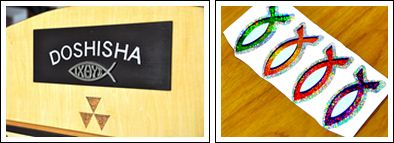 さて、みなさんも聖書や歴史の授業で学んだことと思いますが、キリスト教はこれまでに、その時代のさまざまな荒波を受け、多くの抑圧、迫害を受けながらも、着実に歩んできました。日本では長崎の離島に、潜伏キリシタンの教会が2018年に「世界文化遺産」に指定されたことを知っている人もいることでしょう。
さて、みなさんも聖書や歴史の授業で学んだことと思いますが、キリスト教はこれまでに、その時代のさまざまな荒波を受け、多くの抑圧、迫害を受けながらも、着実に歩んできました。日本では長崎の離島に、潜伏キリシタンの教会が2018年に「世界文化遺産」に指定されたことを知っている人もいることでしょう。
ではなぜ「魚」なのでしょうか。
一説では、12使徒の中でペテロ、アンデレ、ヤコブ、ヨハネの4人が元漁師であったとか、偶像崇拝が禁止されていた当時は、魚やヒツジに置き換えてイエスやその信徒を表現したとも言われています。
そのような経緯で、今日ではこのマ-クのことを「ジーザス・フィッシュ」、「クリスチャン・フィッシュ」と呼ばれています。
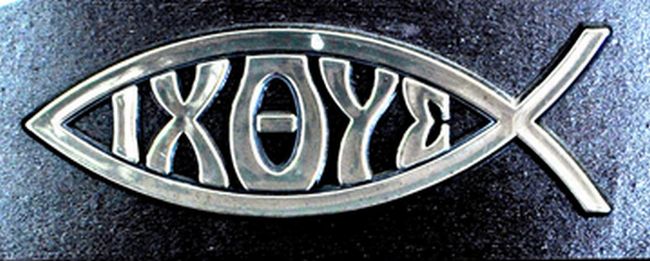
You might have seen the “Worship Schedule” signboard, as shown in the photos, when you entered the Risshikan Building. This time, we want to explain about the fish shaped symbol under the word “DOSHSHA”. Have you noticed it?
This symbol is called “Ichthys”(or “Ichtus”). On the inside, the word “fish” is written in Greek, but the letters are also the first letters of “Jesus Christ, Son of God, Savior”, and it is said that the early Christians used this as a hidden symbol.
You have probably studied in Bible or history classes that Christianity has had to battle through many storms over the years, but has steadily continued despite the suppression and persecution it was put through during these periods of time. You might know that in Japan, on the remote islands of Nagasaki, the church used by the underground Christians was designated as a World Cultural Heritage Site in 2018.
Why is the symbol of a fish used? One theory is that 4 of the 12 disciples, Peter, Andrew, James, and John, were once fishermen. Another is that fish or sheep were used to represent Jesus and his disciples in times when worship was banned.
Because of this history, the symbol is now called a “Jesus Fish” or “Christian Fish”.
《Words》イクトゥス(イクテュス) ichthys ichtus、世界文化遺産 world cultural heritage、ジ-ザス・フィッシュ Jesus Fish、 クリスチャン・フィッシュ Christian Fish
第85回 春を知らせる花々たち
~学内から北方の山々を想う~
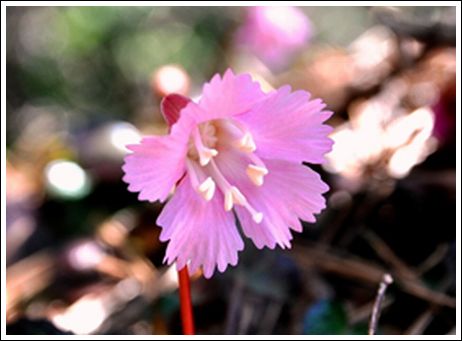
みなさんが登校したとき北方を眺めると、京都北山の山並みが、なだらかでやさしい曲線を表現していることに気づくでしょう。その山々を形づくっている地質体は、今から約2億年前のペルム紀(一部石炭紀)からジュラ紀の時代の海(パンサラッサ海:古太平洋)の海底で堆積した地層です。当時の赤道直下で堆積したチャ-トのような岩石も多く、それらを土台として写真のような美しい花々が咲き誇るのです。
イワウチワは春を代表する花で滋賀比良山系でも群落をつくって咲いています。薄いピンクの花が多いですが、真っ白の花も北山で咲いています。学内ではホトケノザ、ヒメオドリコソウ、オオイヌノフグリなどが咲き誇っています。
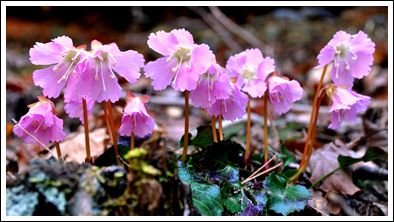 さて、“新型コロナ”が終息を見せない時期は、どうしても目先のことで頭がいっぱいになりますが、是非、学内から三方の山を眺め、そこに息づく花たちのことを想像してみて下さい。この”ひととき”はどんなに忙しい現代人にも、とても意義の大きな大切な瞬間となるはずです。
さて、“新型コロナ”が終息を見せない時期は、どうしても目先のことで頭がいっぱいになりますが、是非、学内から三方の山を眺め、そこに息づく花たちのことを想像してみて下さい。この”ひととき”はどんなに忙しい現代人にも、とても意義の大きな大切な瞬間となるはずです。
私たちには今、ヒトを生物進化の中で位置づける力と、あらゆる生物との「共感力」が求められているように思います。
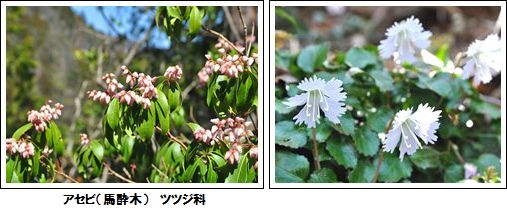
As you arrive at school, I wonder if you have noticed the gentle slopes and lines of the mountains in the north of Kyoto? The geological body that formed these mountains is the strata from the sedimentation that built up from the Panthalassa (Old Pacific) Ocean during the Permian and Jurassic periods over 200 million years ago. Around that time, under the equator there were a lot of chert like rocks in the sedimentation which is now the base for the blooming flowers in the photos.
Nippon Bells are an example of a spring flower that can be found in clusters along the Hira Mountains in Shiga. They are usually a light pink, but we can see white ones in the Northern Mountains. In our school, we can also see that Henbit, Red Deadnettle, Persian Speedwell and so on are blooming now.
With Covid-19 showing no signs of slowing down, it’s easy to be preoccupied with what is in front of us, but we should take a look at the mountains around our school and think about the breathtaking flowers that grow there. While doing so, even a busy person in these modern times should be able to feel the significance of this special moment.
I think that we humans are in a position within the biological evolution where we have the ability and are expected to show empathy towards all living things.
《Words》イワウチワ Nippon Bells、パンサラッサ Panthalassa、生物進化 Biological evolution、共感力 empathy
第84回 建築の魔術師
~コゲラの技能に学ぶ~
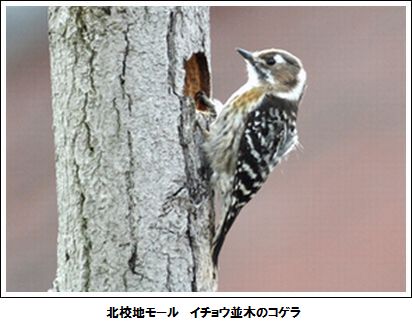
学内では早春の花々が咲き始め、冬鳥のツグミ、ジョウビタキが渡りの準備で慌ただしい動きを見せています。渡りをしないセグロセキレイなど定住の野鳥(留鳥)たちは、にぎやかなさえずりでパートナーにアピールを始めました。
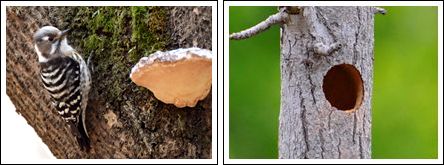 さて、学内には日本最小のキツツキのなかまのコゲラがよく姿を見せ、北モールのイチョウ並木には巣穴を作っています。木を彫るのですから相当のエネルギーを使います。
さて、学内には日本最小のキツツキのなかまのコゲラがよく姿を見せ、北モールのイチョウ並木には巣穴を作っています。木を彫るのですから相当のエネルギーを使います。
前後2本ずつに別れた足の指で幹をしっかりつかみ、尾羽を幹に押し付け安定感を高めます。
驚くのはその巣穴の形です。まず雨が浸入しないように直立かオーバーハングした場所を選び、クチバシで出入り口を円形にしつつ、下方へ10数cm掘り進めます。そこで2~5個ほど産卵し子育てするのです。
機能も優れていますがその入口の円形の正確さには圧倒されます。この形ならば親のみならず我が子の旅だちの際に身体を傷めることはないでしょう。
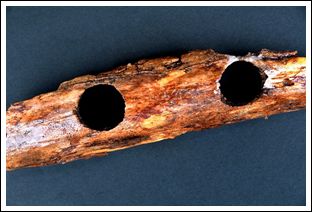
本校の「卒業式」もまもなくです。本校を旅立つ中学3年生が、輝ける未来に向かって強く羽ばたけるように心より祈っています。
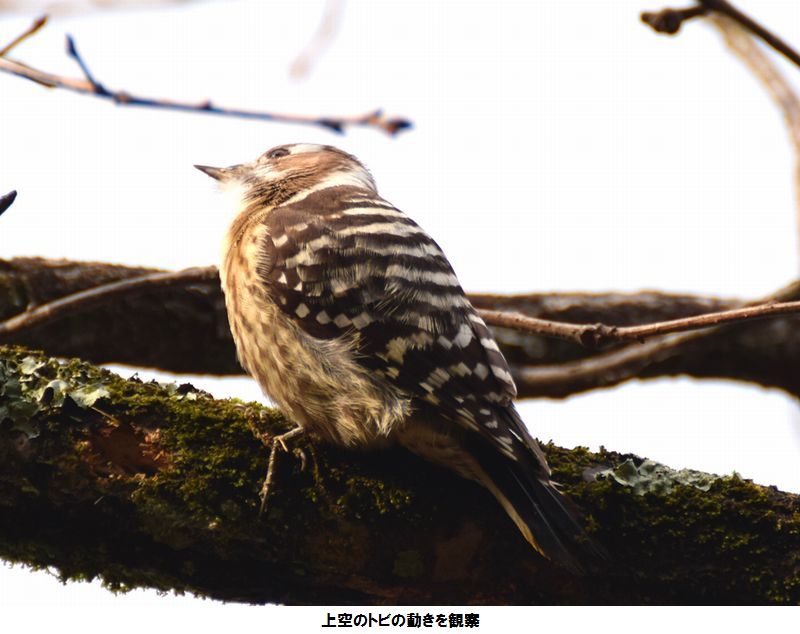
As the spring flowers start to bloom, winter birds, such as the Thrush and Daurian Redstart, are busy preparing for migration. Resident birds that don’t migrate, like the Japanese Wagtail, are busy finding a partner.
In our school, we can see Japanese Pygmy Woodpecker, which is one of Japan’s smallest woodpeckers, flying around the Ginkgo trees and making their nesting holes. The birds chisel into the trees, so it must take a lot energy. They use their spread out claws to hold onto the tree trunk and their tail against the tree trunk for stability. What surprises us the most is the shape of the nesting holes. First, they choose a vertical or overhanging place to stop the rain from entering. Then they use their beaks to make a round entrance and continue to hollow out an area of about 10~20 cm below the entrance. They produce 2~5 eggs and raise them there. The functions of the nest are amazing, but it’s the perfect roundness of the entrance that is most impressive. Because of the shape, the parents and the young birds wouldn’t need to worry about injuries when it comes time to leave the nest.
Our school’s graduation is soon. For the 3rd Year students who leave us, we pray that you all have a bright future ahead of you.
